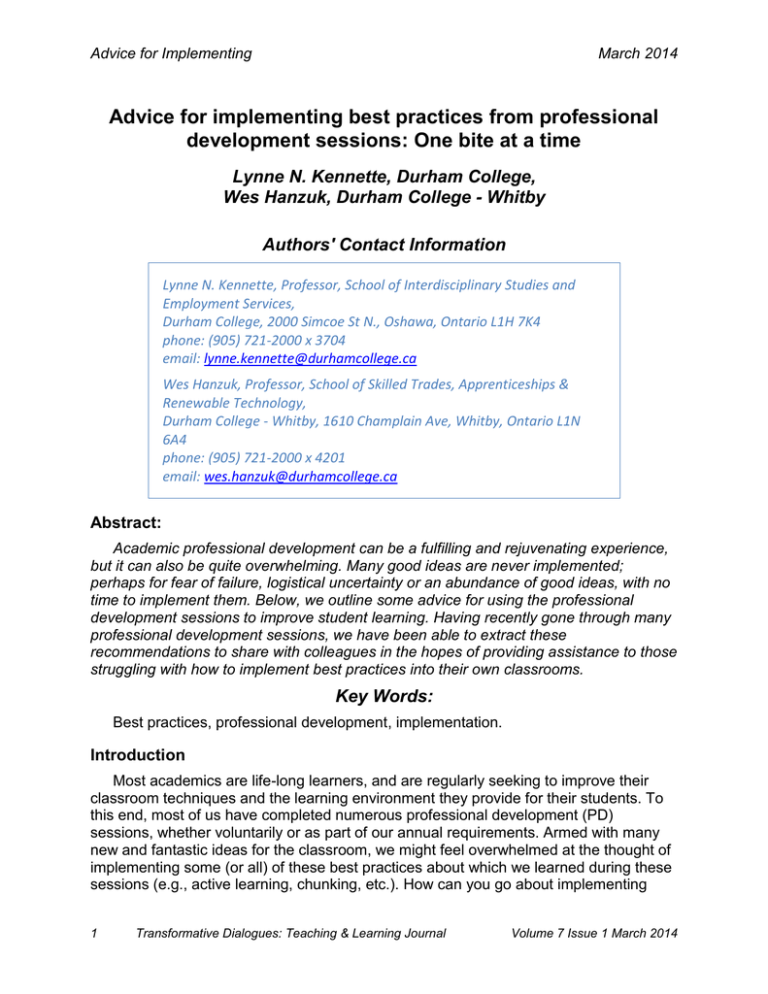Advice for implementing best practices from professional
advertisement

Advice for Implementing March 2014 Advice for implementing best practices from professional development sessions: One bite at a time Lynne N. Kennette, Durham College, Wes Hanzuk, Durham College - Whitby Authors' Contact Information Lynne N. Kennette, Professor, School of Interdisciplinary Studies and Employment Services, Durham College, 2000 Simcoe St N., Oshawa, Ontario L1H 7K4 phone: (905) 721-2000 x 3704 email: lynne.kennette@durhamcollege.ca Wes Hanzuk, Professor, School of Skilled Trades, Apprenticeships & Renewable Technology, Durham College - Whitby, 1610 Champlain Ave, Whitby, Ontario L1N 6A4 phone: (905) 721-2000 x 4201 email: wes.hanzuk@durhamcollege.ca Abstract: Academic professional development can be a fulfilling and rejuvenating experience, but it can also be quite overwhelming. Many good ideas are never implemented; perhaps for fear of failure, logistical uncertainty or an abundance of good ideas, with no time to implement them. Below, we outline some advice for using the professional development sessions to improve student learning. Having recently gone through many professional development sessions, we have been able to extract these recommendations to share with colleagues in the hopes of providing assistance to those struggling with how to implement best practices into their own classrooms. Key Words: Best practices, professional development, implementation. Introduction Most academics are life-long learners, and are regularly seeking to improve their classroom techniques and the learning environment they provide for their students. To this end, most of us have completed numerous professional development (PD) sessions, whether voluntarily or as part of our annual requirements. Armed with many new and fantastic ideas for the classroom, we might feel overwhelmed at the thought of implementing some (or all) of these best practices about which we learned during these sessions (e.g., active learning, chunking, etc.). How can you go about implementing 1 Transformative Dialogues: Teaching & Learning Journal Volume 7 Issue 1 March 2014 Advice for Implementing March 2014 these ideas without feeling completely lost or overwhelmed? We’ve prepared some guidelines to help you get there…one step at a time. Before you attend Depending on your academic discipline, you may be somewhat reluctant to fully engage in the session(s), especially if they’re mandated. This was the case for one of us recently. As a welder, the topics didn’t seem relevant to the classroom (e.g., group work, since welding is traditionally a solo activity). However, in hindsight, a new perspective should have been embraced. The epiphany came much later during the week-long PD session, and the content would have been more beneficial if it had been approached with an open mind from the beginning. So, before you even attend your professional development session(s), prepare yourself mentally and emotionally. Decide that you will approach the session with an open mind, prepared to absorb a fresh new perspective on teaching your class. Collaboration Armed with your newfound knowledge, don’t be afraid to approach a colleague to ask them what they think about your idea for implementation. The best educational experience for students will likely come through collaboration with others. If you get an idea from a PD session, but you’re struggling with how you could adapt it for your classroom, or the content topic for which it would be best suited, most educators would be happy to talk things out with one of their peers. Obtaining a different perspective from someone who teaches in another discipline might also be able provide additional insight into your classroom idea(s). Start small Begin by selecting one or two best practices from the PD session(s). And be sure they are the ones that best fit with your course- you may not want to do an “acting out” scenario with your welding class or a hands-on demonstration with your neuroanatomy class, especially if the facilities aren’t conducive to it. Pick the best idea(s) and start with those, keeping in mind that you might need to adapt techniques or methodologies to fit your particular teaching domain. Use it in one or two classes Don’t implement a technique in all your sessions for all of your courses. It might be a bad idea to flip all of your classes at once: start by flipping one class, or even just one week of classes, to see how it goes. It may work well, but it might not, so set yourself up for success and do a pilot test of it, get student feedback and examine student learning outcomes. Engaging in the SoTL is important whenever you implement something new. Be realistic If you’re planning to implement something in the next semester, will you devote the necessary time over the “break” (Christmas, summer, etc.) to modify your current offering? If not, then don’t attempt to implement it- a new technique or practice is more 2 Transformative Dialogues: Teaching & Learning Journal Volume 7 Issue 1 March 2014 Advice for Implementing March 2014 likely to fail if you don’t realistically have the necessary time to devote to implementing it correctly. Accessibility Will what you’re trying to implement into your classroom be accessible to all of your students? If you happen to know that one particular group of students has physical limitations or very limited funds (and what student doesn’t?), then you may wish to steer clear of some of the ideas you’ve brought back from your PD or adapt it to be more inclusive. For example, you may have learned about a new polling software that students can install for $1.99 on their smartphone. That is fairly inexpensive, but what about students who don’t have a smart phone? Or $1.99 to spare? What about visually impaired students? Could the same outcome (gauging student learning in the classroom) be achieved in another way? Usually it can: for example, you can use multicoloured index cards to poll students in the classroom, to the same end as the smartphone software. Plan, plan, plan How long will it take? Is it worth the time required (both in and out of the classroom)? What are your goals for students with this implementation (teaching or reinforcing essential employability skills or core learning outcomes)? Make a list of all of the ideas you’d like to implement in order of priority. Then, start implementing (and evaluating) these ideas one at a time, ensuring that they contribute to at least one of the class or program’s learning outcomes. Learn from your mistakes It’s always a good idea to try to anticipate problems with a new activity or technique and plan how you will deal with issues if they arise. But realistically, even with the best planning, students may not be receptive to the idea, or it may not work as you had hoped. If it doesn’t work as planned (whether it’s because it was so different from your teaching style that it felt forced or uncomfortable, or because it didn’t match your students’ learning styles, or for various other reasons), reflect on the experience and learn from it. You could try to improve your implementation and use it the following semester, or discard it completely and try a different approach altogether. Concluding remarks Although it is important to update our teaching methods and continuously evaluate them to ensure our students are receiving the best possible learning environment, we also need to be realistic and keep our ambitions manageable. Personal growth and valuable student learning outcomes can be born from a PD session, as long as we take it one step at a time. 3 Transformative Dialogues: Teaching & Learning Journal Volume 7 Issue 1 March 2014

